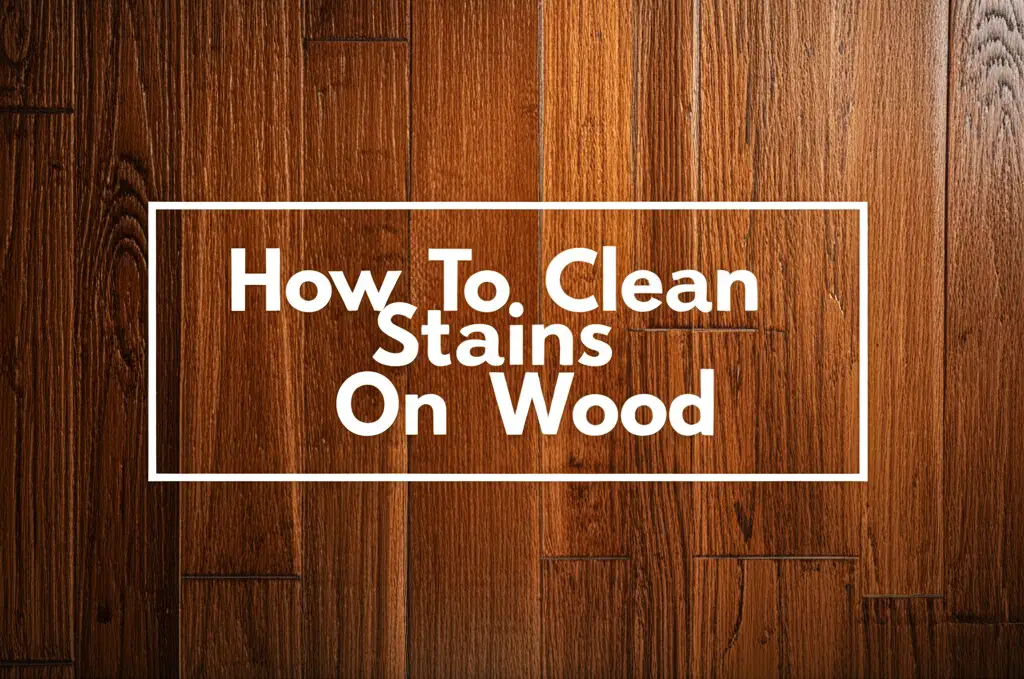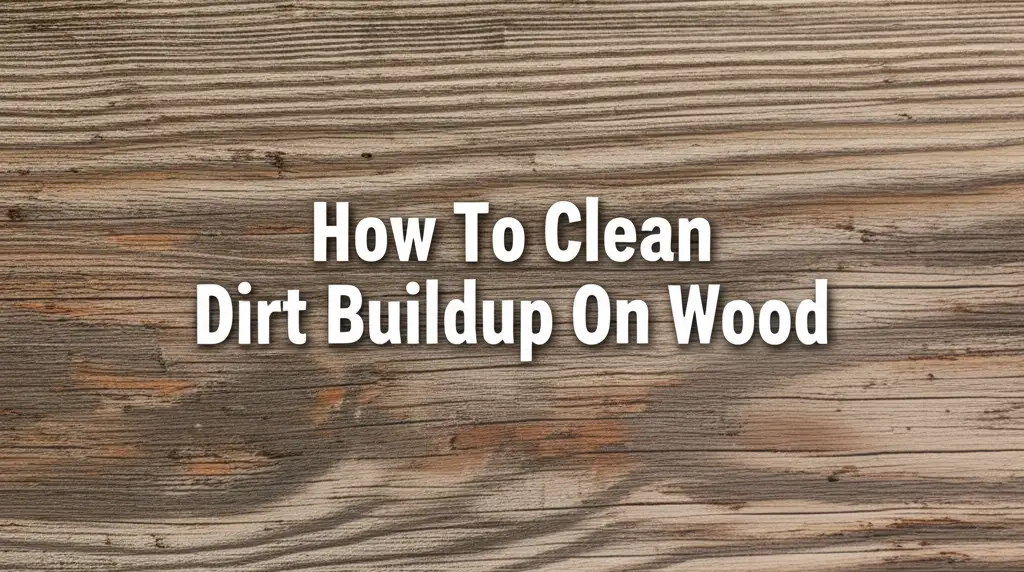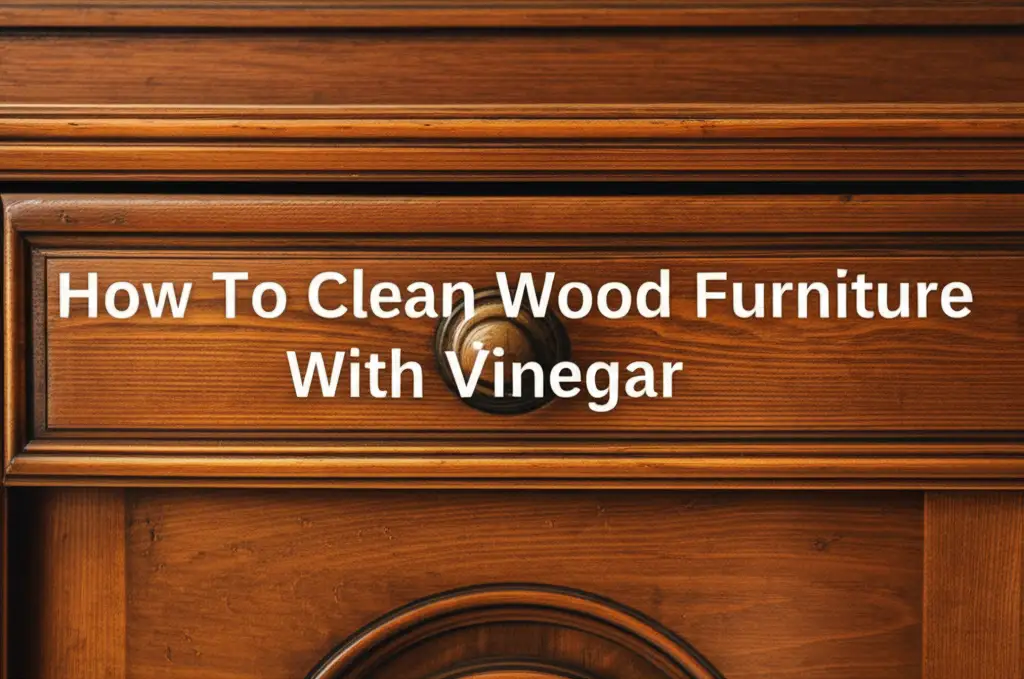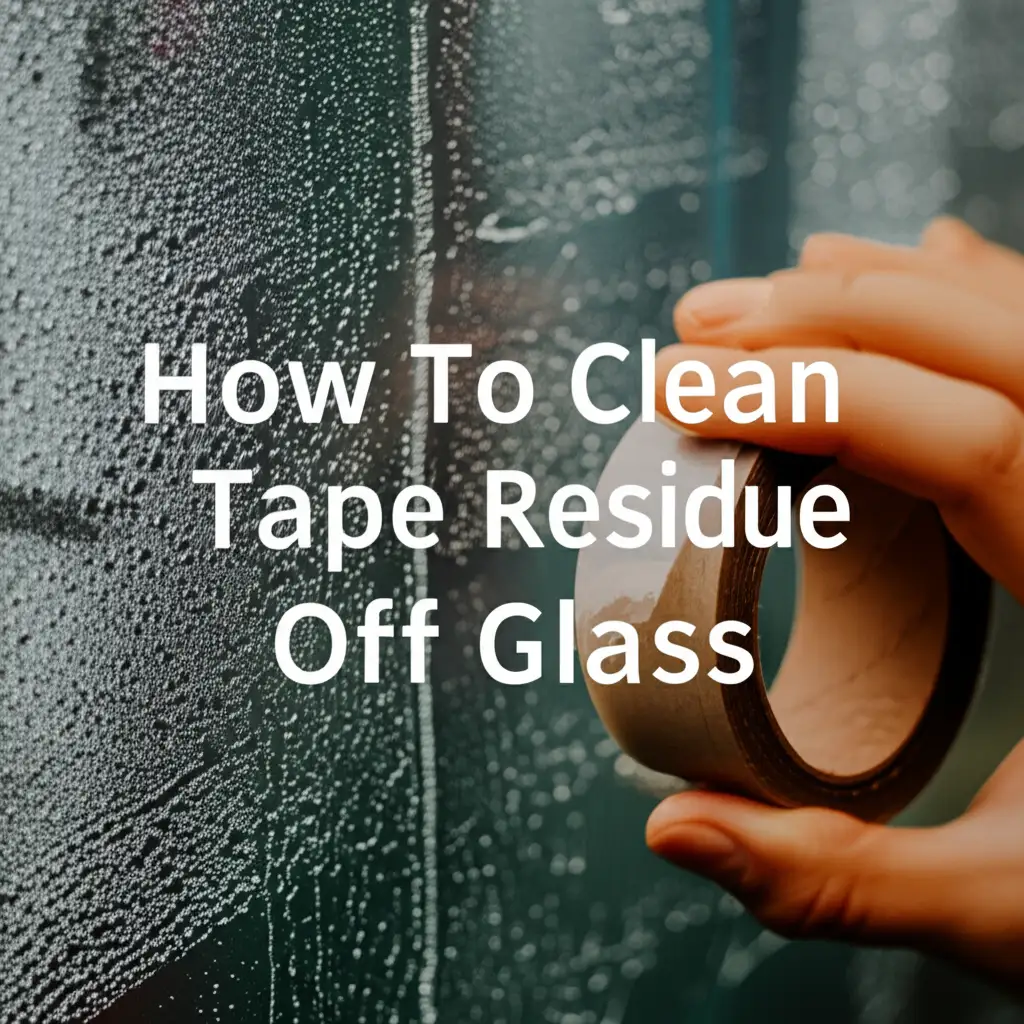· Home Cleaning · 19 min read
How To Clean Stains On Wood

How To Clean Stains On Wood: A Comprehensive Guide
Seeing a stubborn stain mar the beauty of your wooden furniture or floors can be frustrating. Wood adds warmth and character to any home. Stains, however, disrupt this beauty. They make your cherished pieces look worn and neglected. I know this feeling well. I have faced many challenging stains on my own wooden items. This guide will help you restore your wood’s original appeal. We will explore various types of stains and effective methods to remove them. You will learn about safe cleaning agents and proper techniques. We also cover essential tips for preventing future damage. Let’s make your wood shine again.
Takeaway
Cleaning stains on wood requires a gentle yet effective approach. Always identify the stain type and wood finish first. Test any cleaning solution in an inconspicuous area before full application. Use the least abrasive method possible. Timely action and proper drying prevent further damage. Regular maintenance and protective measures keep wood looking its best.
To clean stains on wood, identify the stain type and wood finish. Test mild cleaning agents like dish soap or vinegar on a hidden spot. Apply the chosen solution gently. Wipe the area clean and dry it thoroughly. For tougher stains, use specific remedies like baking soda paste or oxalic acid, always with caution.
Before You Begin: Understanding Your Wood and Its Finish
Before you attempt to clean stains on wood, you must understand your wood item. Different types of wood and various finishes react differently to cleaning agents. This knowledge helps you choose the safest and most effective method. Improper cleaning can cause irreversible damage. I always recommend caution at this stage.
Identifying Your Wood Type: Wood species vary in hardness and porosity. Softwoods like pine absorb liquids more readily. Hardwoods like oak or maple are denser. This difference affects how easily a stain sets in. It also determines how aggressive your cleaning method can be. Know what type of wood you are working with.
Understanding Wood Finishes: The finish on your wood is crucial. Most wood items have a protective layer. This layer can be polyurethane, lacquer, shellac, or varnish. Some wood is unfinished or only waxed.
- Sealed Wood: Most modern furniture and floors are sealed. This finish protects the wood from moisture and spills. You can often use mild water-based solutions on sealed wood.
- Unsealed Wood: Unfinished or raw wood is highly absorbent. Stains penetrate deep into its fibers quickly. Cleaning this type of wood needs special care. It may require sanding after cleaning.
- Waxed or Oiled Wood: These finishes offer less protection. They require gentler cleaning methods. Harsh chemicals can strip the wax or oil. Reapplication of wax or oil is often necessary after cleaning.
The Importance of Spot Testing: No matter the wood type or finish, always test your cleaning solution. Find an inconspicuous area on the item. This could be the back of a leg, inside a drawer, or a hidden corner. Apply a small amount of your chosen cleaner. Wait a few minutes. Check for discoloration or damage. If no adverse reaction occurs, proceed with confidence. This simple step saves you from potential disasters. It gives me peace of mind every time.
Gather Your Arsenal: Gentle Cleaners and Essential Tools for Wood Stains
Successful wood stain removal starts with the right supplies. You do not always need harsh chemicals. Many common household items are effective. These gentle solutions are often safer for your wood and for your home. I keep these basics on hand for quick clean-ups.
Essential Tools:
- Soft Cloths: Microfiber cloths are ideal. They are non-abrasive and highly absorbent. You will need several for cleaning and drying.
- Sponges: A soft sponge can help apply solutions gently. Avoid abrasive scrubbing pads.
- Soft-Bristled Brush: A soft brush, like an old toothbrush, can help work solutions into crevices. Use it gently to avoid scratching the surface.
- Spray Bottle: A spray bottle allows for even application of cleaning solutions.
- Small Bowls: Use these for mixing homemade solutions.
Gentle Cleaning Solutions:
- Dish Soap and Water: A few drops of mild dish soap mixed with warm water create a gentle cleaner. This is effective for light, fresh stains. It works well on sealed wood surfaces.
- White Vinegar: Distilled white vinegar is a versatile cleaner. It removes many types of stains, including hard water spots. Mix it with equal parts water for a diluted solution. For wood floors, a vinegar solution works wonders. You can learn more about how to clean wood floors with vinegar for daily maintenance. Similarly, vinegar is excellent for cleaning furniture. Read our guide on how to clean wood furniture with vinegar to keep your pieces spotless.
- Baking Soda: This acts as a mild abrasive and deodorizer. Make a paste with baking soda and water. It is useful for absorbing grease and tackling water rings.
- Mineral Spirits: Also known as paint thinner, mineral spirits can dissolve oil-based stains. Use it sparingly and in a well-ventilated area. Always test it first.
- Rubbing Alcohol: Isopropyl alcohol is effective for ink stains. Use it carefully, as it can strip some finishes.
- Hydrogen Peroxide: A mild bleaching agent, hydrogen peroxide can lighten dark spots. Use it diluted and only on light-colored wood. Test it thoroughly.
Always remember to use these solutions sparingly. Apply them with a soft cloth. Work in small sections to maintain control. Proper tools and gentle cleaners protect your wood from further damage. They also make the cleaning process much easier.
Spot Treatment: How To Clean Common Stains On Wood Surfaces
Common household mishaps often result in frustrating stains on wood. Water rings, ink spills, and greasy marks are typical culprits. Each stain type requires a specific approach. I have learned through trial and error which methods work best. Addressing these promptly makes removal much easier.
Water Rings (White Stains): These appear as milky white rings or spots. They result from moisture trapped in the finish, not the wood itself.
- Mayonnaise/Petroleum Jelly: Apply a dollop of mayonnaise or petroleum jelly to the water ring. Let it sit for several hours, or even overnight. The oil in these products can lift the moisture. Wipe it away with a clean cloth.
- Toothpaste: Non-gel white toothpaste can also work. Apply a small amount to the stain. Rub gently with a soft cloth in the direction of the wood grain. Wipe clean quickly. Do not scrub too hard.
- Warm Iron: Place a clean, dry cloth over the water ring. Set an iron to a low, no-steam setting. Briefly press the iron onto the cloth for a few seconds. Lift and check. Repeat if necessary. Too much heat can damage the finish, so be very careful.
Ink Stains: Ink can be tricky, but often manageable.
- Rubbing Alcohol: Dip a cotton swab in rubbing alcohol. Gently blot the ink stain. Do not rub, as this can spread the ink. Work from the outside of the stain inward. Continue blotting with fresh swabs until the ink lifts.
- Commercial Ink Removers: Specific wood-safe ink removers are available. Follow the product instructions carefully.
Grease or Oil Stains: These stains leave a dark, greasy mark.
- Baking Soda or Cornstarch: Sprinkle a generous amount of baking soda or cornstarch over the grease stain. These powders absorb oil. Let it sit for several hours, or overnight. The longer it sits, the more oil it absorbs. Brush off the powder. Repeat if necessary.
- Mineral Spirits (for tough stains): For stubborn grease, lightly dampen a cloth with mineral spirits. Gently wipe the stain. Follow the wood grain. Immediately wipe the area dry with a clean cloth. Use in a well-ventilated space.
Food and Beverage Stains: Spills from coffee, tea, or food can leave unsightly marks.
- Mild Dish Soap Solution: Mix a few drops of mild dish soap with warm water. Dampen a soft cloth with this solution. Gently wipe the stain. Dry the area immediately with a clean, dry cloth.
- Hydrogen Peroxide (for light-colored wood): For stubborn or dark food stains on light wood, hydrogen peroxide can help. Dilute it with water. Apply it carefully with a cotton swab. Blot the stain. Rinse the area quickly. This can bleach wood, so test it first.
Always remember to dry the wood thoroughly after cleaning any stain. Excess moisture can cause new problems, such as swelling or discoloration.
Deep Dive: Removing Stubborn and Embedded Stains from Wood
Some stains are more than superficial marks. They penetrate deep into the wood fibers. These require stronger, yet still careful, approaches. Tackling tough stains like mold, pet urine, or dark water spots demands patience and the right products. I have found these methods effective for deep-seated issues.
Mold and Mildew Stains: Mold on wood is not just unsightly; it can damage the wood structure. It also presents health risks.
- Vinegar Solution: Mix equal parts white vinegar and water in a spray bottle. Spray the affected area. Let it sit for an hour. Scrub gently with a soft brush. Wipe clean and dry. Vinegar is excellent for killing mold spores. This method is often enough for surface mold. For severe mold issues, consider our detailed guide on how to clean black mold off wood, which offers more aggressive solutions. Also, if your wood furniture has mold, refer to how to clean mold off of wood furniture for specific advice.
- Bleach Solution (Diluted): For stubborn mold, mix 1 part bleach with 10 parts water. Apply sparingly with a cotton swab or cloth. Blot the stain; do not saturate the wood. Rinse with a damp cloth after a few minutes. Dry immediately. Bleach can lighten wood, so test it first.
Pet Stains: Pet urine leaves a dark, strong-smelling stain. The acid in urine can damage wood permanently.
- Enzyme Cleaner: Purchase an enzymatic cleaner designed for pet stains. These cleaners break down the urine’s organic matter. Follow the product’s instructions carefully. They usually involve saturating the area and allowing it to air dry.
- Hydrogen Peroxide (for dark stains): For very dark pet stains on light wood, hydrogen peroxide can help lift the color. Apply 3% hydrogen peroxide with a clean cloth directly to the stain. Let it sit for a few hours. Check frequently. Once the stain lightens, wipe it clean and dry. It might require several applications. This method can also bleach wood, so exercise caution.
Dark Spots and Water Damage (Black Stains): These are often caused by prolonged moisture exposure or metal reacting with the wood.
- Oxalic Acid (Wood Bleach): For severe dark water spots or black stains, oxalic acid is often the solution. It is a powerful wood bleach. You can buy it in crystal form at hardware stores. Mix according to package directions, usually with water. Apply it to the dark spot with a brush. Let it work for several minutes or hours. It should lighten the stain. Neutralize the area with a baking soda and water solution after applying oxalic acid. Then rinse and dry. Oxalic acid can strip finishes and lighten the surrounding wood, so use it with extreme care and test it thoroughly. Always wear gloves and eye protection.
When dealing with embedded stains, patience is vital. You may need multiple applications. Always dry the wood completely between treatments. If the stain is extremely deep, professional help might be the best option.
The Step-by-Step Guide: Cleaning Wood Stains Safely and Effectively
A systematic approach ensures you clean stains on wood safely and effectively. Rushing the process can lead to more damage. I follow these steps carefully, regardless of the stain’s severity. This method minimizes risks and maximizes success.
Step 1: Prepare the Area and Gather Supplies
- Clear the Area: Remove any items from the stained surface. Make sure you have clear access to the entire area.
- Clean Loose Dirt: Before treating the stain, clean the entire wood surface. Use a soft, damp cloth to wipe away dust, dirt, or debris. This prevents grinding particles into the wood. For general dirt buildup, refer to our guide on how to clean dirt buildup on wood for best practices.
- Gather Tools and Cleaners: Have all your chosen cleaning agents, cloths, sponges, and protective gear ready. This prevents interruptions during the cleaning process.
Step 2: Test Your Cleaning Solution
- Find an Inconspicuous Spot: Locate a hidden area on the wood item. This could be under a table, inside a cabinet door, or behind a leg.
- Apply a Small Amount: Dab a tiny bit of your chosen cleaning solution onto the test spot.
- Observe: Wait a few minutes. Check for any discoloration, dullness, or damage to the finish. If the wood reacts poorly, choose a different solution. This step is critical for safety.
Step 3: Apply the Cleaner to the Stain
- Start Small: Begin by applying a small amount of the chosen cleaner to the stain. Use a soft cloth or cotton swab.
- Work from Outside In: For larger stains, work from the outer edges inward. This prevents the stain from spreading further.
- Gentle Application: Blot or rub very gently. Use light pressure. Do not scrub aggressively, especially on finished wood. This can damage the finish or wood fibers.
- Allow Dwell Time: Let the cleaner sit on the stain for the recommended time, if any. For most mild solutions, a few minutes is sufficient. For tougher stains, longer dwell times may be needed.
Step 4: Blot and Wipe Away the Stain
- Blotting: For liquid stains or pastes, blot the stain with a clean, dry cloth. Do not rub the stain. Blottng helps lift the stain away.
- Wiping: For surface stains, gently wipe the area following the wood grain. Use clean sections of your cloth for each wipe. Avoid reintroducing the stain.
- Repeat if Necessary: If the stain persists, reapply the cleaner. Repeat the blotting and wiping steps. Multiple light applications are better than one harsh application.
Step 5: Rinse and Dry Thoroughly
- Rinse: Dampen a clean cloth with plain water. Gently wipe the cleaned area to remove any cleaner residue.
- Dry: Immediately dry the wood thoroughly with another clean, dry cloth. Do not let water sit on the wood. Excess moisture can cause new water spots or swelling.
- Air Dry: Allow the area to air dry completely for several hours before placing anything back on it. Ensure good air circulation.
Step 6: Assess and Restore (If Needed)
- Assess: Once dry, inspect the area. Has the stain gone? Is the finish still intact?
- Restore Finish: If the cleaning process dulled the finish or removed some of it, you might need to reapply a small amount of wood polish, wax, or oil. This step helps restore the wood’s luster. Sometimes, very old wood floors need cleaning without sanding. Our guide on how to clean old wood floors without sanding provides valuable insights for such situations.
Following these steps ensures a controlled and effective stain removal process. It protects your wood and brings back its natural beauty.
Protecting Your Investment: Preventing Future Stains on Wood
Cleaning stains on wood is reactive. Preventing them is proactive. Protecting your wood surfaces from future damage saves time and effort. It also preserves the beauty and longevity of your wooden items. I believe prevention is always better than cure.
Immediate Spill Cleanup: This is the most critical prevention method.
- Wipe Spills Instantly: Liquids are the biggest culprits for wood stains. Wipe up spills immediately. Do not let them sit for even a few minutes.
- Blot, Don’t Rub: When cleaning a fresh spill, blot it with a clean, dry cloth. Rubbing can push the liquid deeper into the wood.
Use Protective Barriers:
- Coasters: Always use coasters under glasses, mugs, and bottles. This prevents water rings and heat marks.
- Placemats and Tablecloths: Use placemats or tablecloths for dining tables. These protect against food spills, hot dishes, and scratches.
- Felt Pads: Place felt pads under lamps, vases, and decorative items. This prevents scratches and marks from friction.
Regular Cleaning and Maintenance:
- Dust Regularly: Dust can be abrasive. Regular dusting with a soft, dry cloth prevents buildup. It also keeps the surface clean.
- Gentle Cleaning: Clean wood surfaces with a mild wood cleaner or a damp cloth periodically. Avoid harsh chemicals. They can strip the finish.
- Follow Manufacturer’s Instructions: Always check the care instructions for your specific wood furniture or flooring. They often provide valuable maintenance advice.
Proper Environmental Control:
- Humidity Control: Wood expands and contracts with changes in humidity. Extreme fluctuations can lead to cracks or warping. Use a humidifier in dry climates and a dehumidifier in humid ones. Maintain consistent indoor humidity levels.
- Avoid Direct Sunlight: Prolonged exposure to direct sunlight can fade wood finishes. It can also cause wood to dry out and crack. Use curtains or blinds to protect your wood from harsh sun rays.
Apply Protective Finishes:
- Waxing: For waxed wood, reapply wax every few months or as needed. Wax provides a protective layer. It enhances the wood’s luster.
- Polishing: Use a quality wood polish specifically designed for your wood finish. Polishes protect and shine. Avoid silicone-based polishes. They can build up over time.
- Sealing: For unsealed or frequently used wood, consider applying a durable sealant. Polyurethane or varnish offers robust protection against spills and wear.
By incorporating these preventive measures into your routine, you can significantly reduce the risk of future stains. Your wood will stay beautiful and last longer.
When DIY Isn’t Enough: Considering Professional Wood Stain Removal
Sometimes, despite your best efforts, a stain on wood might be too severe. Or the wood piece might be too valuable or delicate for DIY attempts. Knowing when to call a professional can save your wood from irreparable damage. I have learned to recognize these situations. It is wise to seek expert help when necessary.
When to Seek Professional Help:
- Deeply Embedded Stains: If a stain has penetrated beyond the finish and deep into the wood fibers, it becomes much harder to remove. DIY methods might only address the surface. Professionals have specialized tools and chemicals that can extract deep stains without destroying the wood.
- Extensive Water Damage: Large areas of water damage, especially if they cause swelling, warping, or blackening over a wide surface, are challenging. These often require sanding, refinishing, or even wood repair. This is beyond typical home cleaning.
- Mold Infestation: While small mold spots can be treated at home, extensive mold growth indicates a deeper moisture problem. It might have compromised the wood’s structural integrity. Professionals can assess the extent of the damage. They can properly remediate the mold and prevent its return.
- Antique or Valuable Wood Pieces: Heirloom furniture or antique pieces are often irreplaceable. They require a gentle touch and specific knowledge about historical finishes and wood types. A professional restorer has the expertise to clean stains without devaluing or damaging the piece. Their methods preserve its integrity.
- Unknown Finishes or Wood Types: If you are unsure about the wood type or its finish, experimenting with DIY cleaners is risky. A professional can identify the wood and finish. They can recommend the most appropriate and safe cleaning or restoration process.
- Failed DIY Attempts: If you have tried several DIY methods without success, or if your attempts have made the stain worse, stop. Further experimentation can cause permanent damage. A professional might still be able to salvage the piece.
- Time and Resources: Restoring severely stained wood can be time-consuming and labor-intensive. If you lack the time, proper tools, or confidence, a professional service is a good investment.
What Professionals Offer: Professional wood restorers or cleaners offer more than just stain removal. They provide comprehensive services:
- Expert Assessment: They can accurately diagnose the stain and wood condition.
- Specialized Techniques: They use commercial-grade products and techniques. These are not available to the average homeowner.
- Refinishing and Repair: Professionals can often repair damaged wood. They can also refinish surfaces after stain removal. This brings the wood back to its original condition.
- Guaranteed Results: Reputable professionals stand by their work. They ensure your wood is restored properly.
While DIY cleaning is empowering, knowing when to step back and seek professional help is a mark of a responsible homeowner. It ensures your treasured wood items receive the best possible care.
FAQ Section
Q1: Can I use bleach to clean all types of wood stains? A1: No, you should use bleach with extreme caution on wood. Bleach can lighten wood, often unevenly, and might strip certain finishes. It is typically only recommended for severe mold or very dark, deeply embedded stains on lighter woods. Always dilute bleach heavily and test it in an inconspicuous area first.
Q2: How do I remove black water stains from wood? A2: Black water stains are often caused by water reacting with wood tannins or metal. For these, oxalic acid (wood bleach) is often effective. Apply a solution of oxalic acid to the stain, following product instructions carefully. It typically requires rinsing and neutralizing afterward. Test it on a hidden spot first as it can lighten the wood.
Q3: Is vinegar safe for all wood finishes? A3: Vinegar is generally safe for sealed wood finishes when diluted with water. However, undiluted vinegar can be too acidic and might dull or strip some finishes over time. Avoid using vinegar on waxed or unsealed wood, as it can remove the wax or penetrate the raw wood, potentially causing damage. Always dilute it and test first.
Q4: How long should I let a stain remover sit on the wood? A4: The dwell time for a stain remover varies. For mild solutions like dish soap, a few minutes is usually enough. For tougher stains or specialized products, check the product instructions. Some remedies, like baking soda paste for grease, may need to sit for several hours or overnight. Always monitor the wood during this time.
Q5: What should I do if a stain remover dulls the wood finish? A5: If a stain remover dulls the finish, it might have partially stripped it. First, ensure the wood is completely dry. Then, you can try applying a wood polish or furniture wax appropriate for your wood’s finish. If the dullness persists, you may need to reapply the original finish to that specific area or consider professional refinishing.
Q6: Can I use commercial multi-surface cleaners on wood? A6: Many multi-surface cleaners are too harsh for wood. They can contain ammonia or other chemicals that strip wood finishes, cause discoloration, or leave a sticky residue. Stick to cleaners specifically designed for wood. Or use gentle, homemade solutions like diluted dish soap or vinegar for routine cleaning.
Conclusion
Cleaning stains on wood might seem daunting, but it is a manageable task with the right knowledge and tools. You have now learned how to tackle various types of wood stains, from common water rings to stubborn mold. Remember, identifying your wood type and finish is the first step. Always test any cleaning solution in a hidden area. Gentle applications and thorough drying are essential for success.
Protecting your wood from future stains is just as important. Regular maintenance, immediate spill cleanup, and using protective barriers will keep your wood surfaces looking beautiful for years. For those truly challenging stains, do not hesitate to consult a professional. They have the expertise to restore even severely damaged pieces. By following these guidelines, you can ensure your wood furniture and floors remain a source of pride in your home. Take action today and bring back the natural splendor of your wood. Your efforts will be well worth it.
- wood stain removal
- clean wood
- hardwood cleaning
- furniture care
- DIY cleaning
- stain prevention
- wood maintenance




